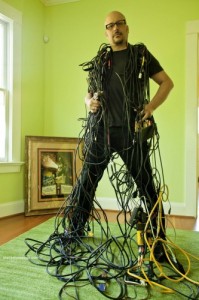
As part of my work for Blackstone Edge Studios, I have helped put together several short films to accompany concert performances. I’ve cobbled together a fairly simple video distribution system that feeds one video signal (VGA from a laptop) to four 42″ LCD HDTV monitors, one HD video projector, and seven small (6″ or so) TV monitors with headphone outs, one for each member of the band. Stored in suitcase are all of the ebay-sourced components mounted on a board – similar to a guitarist’s pedal board, along with many, many cables. All told, there are hundreds of feet of wire. Frankly, it’s a bit of a mess.
Since the start, I’ve been wondering if the whole thing could be made wireless on a small budget. I’ve looked into several methods, including low power HDTV transmitters, as most of the monitors have built-in TV tuners. Recently the Raspberry Pi was released – a $35 linux micro-computer with USB (for keyboard, mouse, storage, WiFi adapters) accelerated HDMI video output and GPIO pins. At that price, I’m thinking there must be some way to make our wireless video presentation possible. I’ve put lot of thought into how exactly this might work, though admittedly the tech behind a DIY, fully wireless setup might be a bit of a reach for me right now.
I’m going to take this project one step at a time. I’ll start by trying to remove the laptop from the setup. We have been using a Windows 7 laptop with an extended desktop (laptop screen + HD VGA output) running PowerPoint in presentation mode. Each video is a “slide” presented on the VGA output, controlled via the laptop’s keyboard, trackpad and screen. While this setup works, it can get technical for a music performance setup. I want something plug and play – turn it on, and it’s ready to start playing videos.
My initial hope is to transfer video files via FTP to an SD Card connected to a Raspberry Pi setup with an LCD character display and buttons to start and stop videos and step through a playlist. For this first phase, the Pi’s HDMI output will be converted to VGA, which will be routed through the existing miles of cable. Parts are on order, and I hope to have a physical prototype ready for rehearsals by mid-March. The software part will be challenging, as I’m finding scarce resources when it comes to controlling HD video playback through Python or C on the Pi. Add this to my general ignorance when it comes to linux, python and/or C and… well, it will be a challenge.